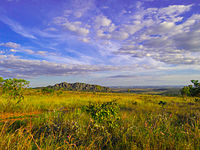
Photo from wikipedia
Hymenoptera are the third largest insect order and is one of the most important ecological agents in terrestrial ecosystems, while terrestrial flooded areas are considered priority for conservation due to… Click to show full abstract
Hymenoptera are the third largest insect order and is one of the most important ecological agents in terrestrial ecosystems, while terrestrial flooded areas are considered priority for conservation due to their uniqueness. We present the first inventory for bees (Apoidea) and wasps (Vespoidea) and describe their alpha, beta, and gamma diversity s in the Brazilian Pantanal to evaluate the effect of the flood intensity on the community structure. We tested the hypothesis that areas with different profiles would present less similar composition, for this, sampling was carried out in the Brazilian Pantanal between November 2015 and March 2016 using passive traps and active search with entomological net in 19 areas distributed in five flood categories. Ecological metrics were used to describe the community, as well as multivariate analyzes for community interpretation. We collected 3342 individuals belonging to 377 species and eight families and expected 532 (± 23) species of Apoidea and Vespoidea. Different areas presented low similarity and the compositions of the communities tended to be different, mainly between the extremes of the flood profile for different families. The biological characteristics of representatives from the highest taxonomic levels (Subfamily, Tribe) are important for occupation of the areas in the Pantanal. Describing the fauna and understanding how it is influenced by flooding history provides tools for conservation strategies in the Pantanal and further effort is needed to preserve distinct areas within the biome.
Journal Title: Journal of Insect Conservation
Year Published: 2018
Link to full text (if available)
Share on Social Media: Sign Up to like & get
recommendations!